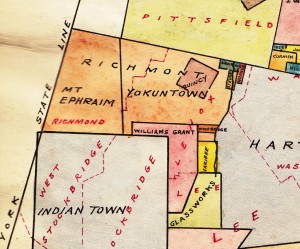
Pre-Revolutionary Lenox Dale
As Jan Chague points out in her excellent new book, History of Lenox Furnace and Lenox Dale, the official history of Lenox Dale begins with a 500 acre 1739 grant to John Larrabee.
What Did Larrabee Want?
Although the grant was destined to encompass the primary site of greater Lenox’s industrial operations, it is doubtful that potential entered Larrabee’s mind.
Larrabee was awarded the grant (plus some cash)in response to his complaints about not being reimbursed for the expenses he incurred managing Fort William in the Boston Harbor.
It is doubtful he ever saw the place or had any plans for it other than cashing in when land values rose. This, in fact, he did, selling to Charles Goodrich in 1760.
Why Not Industry?
Short answer — too soon. Many of the components for even rural industry were not yet in place.
- No Peace – The French and Indian Wars went on until 1763 and made colonists (and investors) fear commitment to western Massachusetts, Vermont and upstate New York.
- No Government – Berkshire County was not formed until 1761, and, although there were settlers in Lenox as early as 1751 (Jonathan Hinsdale), the town of Lenox was not founded until 1767.
- No Transportation – The Housatonic River this far north was not navigable and Berkshire County had a few footpaths but no roads to speak of in the 1730’s
- No Capital – By 1739, the English Industrial Revolution was underway, but the role of the colonies in the British mercantilist scheme was to supply raw materials – not manufactured goods. The colonies had no independent currency or banking system.
Moreover, there is no indication that Larrabee knew of the iron ore deposits in Lenox, Richmond and West Stockbridge that were soon to jump start manufacturing in Lenox Dale.
Subsistence farming was the primary occupation and Larrabee, correctly, was probably counting on settlers to move west, clear the land, and eventually turn it into property suitable for farming.
The groundwork for industry was slowly but surely being laid but wouldn’t be fully in place until after the Revolution.
